ANTIQUE CANNABIS MEDICINES
Chapter 7
Chapter 7

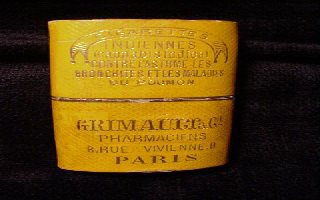 Grimault |
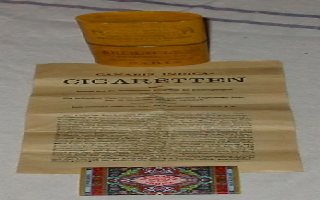 Grimault |
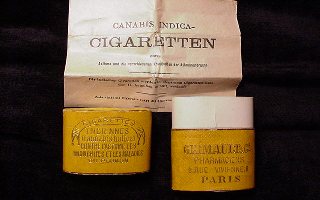 Grimault |
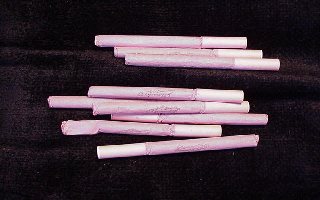 Grimault |
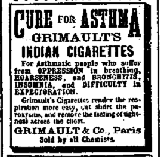 Grimault |
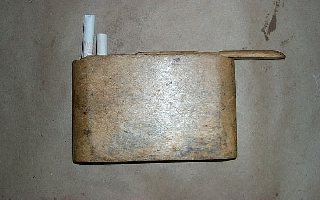 Cig Case |
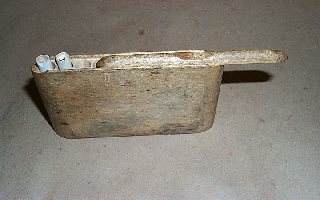 Cig Case |
 Cig Case |
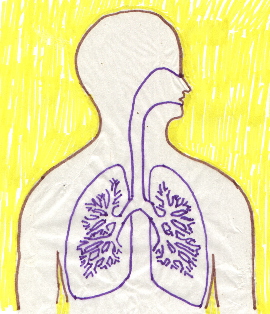 Asthma |
 Sales Brochure |
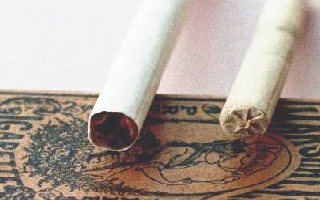 Compare |
Compare |
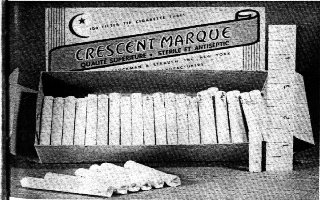 Cresent Marque |
 Bambu |
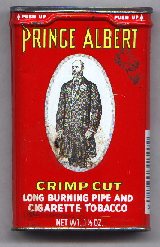 Prince Albert |
|
|
Because of our present day disgust for the tobacco industry, one is tempted to dismiss the idea of a medical (life saving) cigarette altogether. But that would be a mistake: Cannabis, in its smokable form, has been known to quickly stop full-scale asthma attacks. A medical fact that, while only scientifically proven in the late 20th Century, did not go unnoticed by 19th Century medical practitioners.
7.1 -- THE CIGARETTE --As a DRUG INJECTION MECHANISM:
Perhaps the best way to understand the subject is to pretend that someone right in front of you is having a full-blown asthma attack. Normally asthmatics are suppose to take oral medications to prevent such attacks, but should one occur, most asthmatics also carry small portable steroid dispensing inhalers with them, just in case. These (fast acting) inhalers have the power to bring the medicine (usually some sort of steroid) directly right into the lungs.
However, this presumes that the asthmatic patient has access to today's modern medicines, and obviously this was not always the case. For example, inhalers did not become technically practical until after WWI, and while there were steam or vapor medical delivery devices available; (realistically speaking) how practical are they to a farmer that is plowing his field. Where is he going to get the steam etc.? As for perfume or droplets style dispensers, they are all but worthless for this purpose.
To make the matter worse, it must also be pointed out, that the "hydraulic syringe" was not even reliably available to the medical profession until the mid-1860s. And I, for one, can attest to the fact that medicines designed specifically for hypodermic syringes were not available for many decades there after.
And while orally ingested medicines were available in the 19th Century, great emphasis must be made that one of the great disadvantages of all oral medicines, is the possibly life-threatening delay (some orally ingested medicines take hours) before they begin to take effect.
Thus, cigarettes became, by default, the only practical method of delivering fast-acting medicines into the human body.
7.2 --- WHAT IS ASTHMA? [See section]
The author, being a historian, makes no pretence to having any medical training, and so has made every effort to avoid technical subjects wherever possible. In addition (just to hammer down this point), he admits that he has on various occasions been caught, very red faced, making some very (medically speaking) inaccurate statements. However, the subject of actual medical cigarettes, is so important, and is so misunderstood that it would be irresponsible not to dwell into it. . . . [More]
7.3 -- ANTI-ASTHMA CIGARETTES:
Because of our present day disgust for the tobacco industry, one is tempted to dismiss the idea of a medical (life saving) cigarette altogether. But that would be a mistake: Cannabis, in its smokable form, has been known to quickly stop full-scale asthma attacks. A medical fact that, while only scientifically proven in the late 20th Century, did not go unnoticed by 19th Century medical practitioners. To quote a major medical journal of its day:
CIGARETTES OF CANNABIS INDICA.
Medical Times and Gazette. Medical News; Oct 1870; 28, 334;
"The cigarettes of Cannabis Indica, made by Gremault, of Paris, have been found most efficient in the treatment of affections of the organs of respiration and circulation, no less than in affections of the central and peripheral nervous system. The unpleasant effects which so often follow the internal and subcutaneous use of opium and of Cannabis Indica are not produced by the cigarette. There use is recommended (1) in spinal neuroses, and epilepsy; (2) in neurosis of the sensory nerves, neuralgia of the teeth, branches of the fifth pair, the sciatic nerves; (3) neuroses of the motor nerves, spasm of the throat air passages; (4) affections of the sympathetic nerves, hysteria, and other diseases not attended with plethora, and congestion of the head, heart, or lungs. They are especially useful in asthma, peruses, spasm of the stomach and intestinal canal, nervous palpitation of the heart, and exert a quieting influence over the whole nervous system. " 7.4 -- INDIAN CIGARETTES by Grimault & Co.: [See Pictures]
This particular brand "Indian Cigarettes" [1] manufactured by the Grimault Corporation, is of special interest to us. This is due mainly to the fact that it seems to have been the ONLY established brand name of Cannabis Cigarettes offered for sale in this country. Also, remembering that medical marihuana cigarettes were quite legal back then, it is one of the most highly documented brand names available.
According to the United Nations [Bulletin on Narcotics 1951],[2] Under the subtitle: "Preparations exempted from the control measures of the Narcotics Conventions: The formula is/was as follows:
Preparation # 5: Indian Cigarettes of Grimault (Dr. Ph. Chapelle)
Government: Siam
Notification: C.L.302.1930.III. Annex I
Formula:
Which brings up an interesting subject; Again, according to a United Nations [Bulletin on Narcotics 1962],[3] the following is stated:
"Preparations made from extract or tincture of cannabis were not mentioned in the 1925 Convention, but in 1935 were brought within the control of the Convention by a decision of the Health Committee of the League of Nations under article 10 of the Convention. Such preparations are in some respects under a stricter control than the extract and tinctures themselves. Preparations made from the extract and tincture which are capable only of external use, and a medicinal cigarette called "Indian Cigarettes of Grimault" (Dr. P. H. Chapelle) are exempted from control.[ League of Nations document C.136.M.87. 1939. III ]Which brings up a good trivia question; Are these cigarettes, "Under InterNational Treaty Law," still legal today? Hmmm! An interesting question, but one beyond the subject and interests of antique collectors.
Obviously Grimaults were an international brand of cigarettes, with sales beginning before the 1870's. However, here within the United States, its first mention (that the museum has been able to document) was in a pharmacy trade magazine mention in 1901, although most assuredly, it was being offered for sale, long before that.


The Pharmaceutical Era (Blue Book) 1901 pp67
At the other end, [most assuredly as a direct result of the Marihuana Tax Act] its last (documented) legal mention of Grimaults occurred on May of 1938 in another trade magazine, the Druggist circular. Although, obviously, it stood on drug story shelves long after that.


Druggist Circular (Red Book)-- May 1938 pp80
Additionally, it should be noted that while outlawed in our country, they were still legal in other countries. Thus some of them still made their way in. According to the December 1980 issue of "Drug Enforcement Magazine" [a semi-official DEA magazine]; "These cigarettes were made in Paris, France, by Grimault and Sons, and contained Belladonna and Cannabis Indica. They were distributed up until the 1930s, mostly in Colombia, Guatemala, Honduras and Nicaragua; to relieve the symptoms of asthma and bronchitis."
7.4.1 -- GRIMAULT's and the Reefer Madness Era:
The author has taken great pains to avoid this subject wherever possible. Scantly clad coeds, jumping out of windows, and axe murderers (all allegedly committing their acts while under the influence of Medical Cannabis), really have no place in a book dealing with antique medicines. Unfortunately, one can't seem to get away from the subject: For unlike other antique medicines which simply died out as better medical advances came along. Medical Cannabis was Killed.
Perhaps, the following short article, from a Jamaican (NOT an American Newspaper), best helps explains the times and the reasons why Cannabis cigarettes are no longer available in drug stories today.
The Daily Gleaner [Kingston, Jamaica] Oct. 23, 1946 pg 1The reason I've chosen this one example, is because the very same newspaper, the Daily Gleaner (of Jamaica), was at the same time carrying large bold face ad's for Grimaults Cannabis Cigarettes. But of course, they were "Cannabis" NOT "Marihuana" cigarettes!
American Seamen said Taking Ganja Into Australia
'To Give White Girls'
SYDNEY, October 22: Marihuana one of the world's worst drugs, which is known in United States as "Mary Warner", was being brought to Australia by American coloured seamen to give to white girls, the police prosecutor suggested in the central police court today. . . . Marihuana is known as ganja in Jamaica.
7.5 --- Other BRAND NAME CANNABIS CIGARETTES:
Were there any other brands of pre-1937 Medical Cigarettes? The answer is Maybe, Probably, Most Assuredly, but other than causal references, this museum has not been able to document any. For example; Samuel Hopkins Adams, in his book "The Great American Fraud," talks about a German brand of "Hashish" cigarettes, but we suspect that he was actually talking about Grimualts. We have been able to locate the following:
7.5.1 --- CRESCENT MARQUE Cannabis Cigarettes: [See Picture]
The given photograph was obtained from a United Nations Publication [Bulletin on Narcotics" Vol. 3, No. 1, Jan. 1951 pp9]: The caption reads: "Marihuana (Indian Hemp) cigarettes seized in the illicit market." Which is all the information that this museum knows about the product. We do not even know if they were actual cigarettes or just empty tubes. Nor if they were used for recreational or medical purposes.
7.5.2 --- CANNADONNA (Asthma cigarettes):
This was a non-American brand of medical cigarettes (which is why we know so little about it). The label reads: "Obtainable from all chemist or Direct from Frid Stone M.R.S.V. Chemist. 9 Baker Pd Ashburton Tel, WM 2328 -- also gives great relief in catarrh, hay fever etc. This is the only asthma cigarette made especially to suit Australian conditions. Obtainable also for Pipe smoking. Directions: One to be smoked during attacks, a mixture of tobacco cannabis & belladonna." (No picture available) To our knowledge, it was never directly sold in North America, but some of them could have made their way in.
7.5.3 --- Antidotal (smoking) Uses:
The following is taken from the "1914/Report of investigation in the State of Texas" [Made public on April of 1917], on the subject of Marihuana along the Mexican border; -- Author: Smith, R. Publication: Washington: Dept. of Agriculture, Bureau of Chemistry:
"During this investigation I collected several samples of Cannabis Indica, both in bulk and package form . . . together with some Marihuana cigarettes which were seized by the customs officials at El Paso. I would call special attention to the two samples of the one-ounce package put out by Parke Davis and Co. of Detroit. The larger container is the more recent on the market and you will notice that the contents are in loose form convenient for smoking purposes. . . . manufacturing drug houses in the United States are putting on the market foreign Indian Hemp or Cannabis Indica in bulk or in package form, which is being sold by the retail druggists solely for smoking purposes . . . . The sale of the drug is not confined to Mexicans. American soldiers, negross , prostitutes, pimps, and a criminal class of whites in general are numbered among the users of this weed. . . . A retail drug store in San Antonia, catering exclusively to Mexican treads. . . There is no question but that it is purchased for smoking purposes. I have calls for it practically from Mexicans only, although in the last few months I have noticed several American negroes and whites of the lower class are beginning to call for it." [4]Point being made; there must certainly must have been numerous [Brand Named] cigarettes sold in the U.S. that contained Cannabis. Unfortunately documentation is lacking and thus we cannot state for sure.
7.6 --- MEDICAL CIGARETTE CASES: [See Pictures]
The pictures show a Cigarette holder for medical cigarettes used around the late 19th Century, but perhaps the term, "Portable Medicine Holder" would have been more appropriate. Notice the somewhat ugly, yet sturdy construction. In a time before aerosol spray or hypodermic needle delivery, the cigarette was the only way to get medicines into the body quickly -- in seconds, as opposed to the hours needed by oral ingestion medicines. Therefore these cigarette holders were valued for their ability to protect their contents, not their beauty.
7.7 --- CIGARETTE COMPARISON: [See Pictures]
These Marshall's Asthmatic cigarettes (era 1880-1920s), which may or may not have originally contained Cannabis, nevertheless provide a good example of medical cigarettes form that era. Note the difference in size between a modern-day (tobacco cigarette) and the smaller medical cigarette.
[See Picture]: The back end or filter side of a typical 1880-1920's era medical (right) and modern-day tobacco cigarette (left). Notice that the "filter" on the 1880s cigarette consists of nothing more than an empty cylinder at the end of the cigarette.
[See Picture]: : The front end of a typical 1880-1920s era medical (left) and modern-day (right) tobacco cigarettes. Note that in addition to the size differences, the medical cigarettes must make use of a wrapper or closed ended. It is assumed that this is to prevent the contents from falling out.
7.8 --- TRIVIA :
Trivia is fun, but it should be noted that neither one of these products became popular until AFTER the passage of the anti-Medical Marihuana laws.
7.8.1 --- Bambu (cigarette Paper): [See Picture]
According to the; Bulletin---Bureau of Criminal Investigation - New York State Police Vol. 16 No. 3 1951 " MARIHUANA"
"Cigarettes,' which are also referred to as "reefers" or "muggles", are usually hand-rolled, although occasionally some will appear as if they have been prepared on a home-type cigarette roller. The paper used in marihuana cigarettes is often of double thickness, which is necessary because broken pieces of twigs and leaves readily pierce the single thickness of ordinary cigarette paper. . . . . Our experience obtained from the examination of many marihuana cigarettes has revealed a peculiarity; most of the cigarettes are made with a particular brand cigarette paper; namely, Bambu. This Bambu paper is a product of Spain and undoubtedly is slightly cheaper than American made cigarette paper. Although there is no known definite reason why Bambu paper is desired,[5] it is felt that the persons making marihuana cigarettes are more familiar with this Spanish brand than the American brands. . . . . In our experience, we have never found a cigarette made with ordinary tobacco in which Bambu paper has been used. . . . We have found some marihuana cigarettes not made with Bambu paper but in the majority of cases, Bambu has been used."
7.8.2 --- PRINCE ALBERT (in a CAN): [See Picture]
JOKE:
Customer to store keeper: Do you have Prince Albert in a Can?
Store Keeper: Yes.
Punch Line: Well let him out.
Ha. Ha. Ha.
Ok, a sick joke, but according to the semi-official magazine -- "Drug Enforcement" [Dec 1980]
"A Prince Albert Tobacco tin. The "tin" was widely accepted as a unit of measurement on the street, and still is, only now it is known more commonly as a "lid of grass."It should noted [historically speaking] that not only was it a widely available product at the times but that a tin of Prince Albert Tobacco was less expensive than most other brands.
[1] With reference to Indians from India.
[2] UnitedNations\BulletinOnNarcotics1951Issue4-001.htm Subsection: Preparations exempted from the control measures of the Narcotics Conventions
[3] Bulletin on Narcotics - 1962 Issue 4 http://www.undcp.org/bulletin/bulletin_1962-01-01_4_page005.html
[4] - This report, containing with numerous racial stereotypes can be obtain through the museum.
[5] Maybe it has something to do with the cost$$
 Back to the Last Chapter |
 BACK TO MAIN INDEX PAGE |
 On to the Next Chapter |